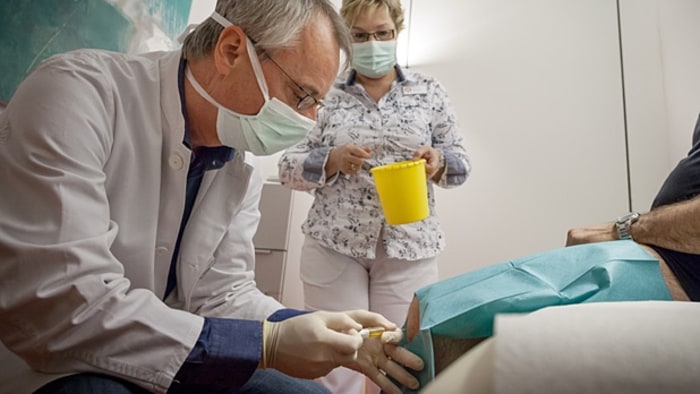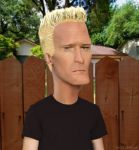The Body That Heals Itself

Tags: USA
The Body That Heals Itself published by Evanvinh
Writer Rating: 5.0000
Posted on 2016-03-24
Writer Description: Evanvinh
This writer has written 733 articles.
In 2011, after sitting out much of the season due to chronic pain in his right knee, Los Angeles Lakers star Kobe Bryant – who already had undergone three knee surgeries – decided to try something different to get his game back: He traveled to Düsseldorf, Germany. That's where a physician named Peter Wehling invented an innovative procedure called Regenokine, which uses the body's own anti-inflammatory proteins and human-growth factors to reverse pain and chronic injuries. By all accounts, Bryant's visit was a success – he went from a possibly career-ending injury to being back on the court. "I can run. I can jump. I can run the track. I can practice every day. Those are things I couldn't do last year," he told Yahoo! Sports at the time.
Bryant isn't the only high-profile patient to visit Wehling's clinic.Alex Rodriguez went to Wehling for knee and shoulder pain, Olympic volleyball player Lindsey Berg treated her arthritic left knee, and even Pope John Paul II underwent treatment for arthritis.
Regenokine is a patented procedure that involves drawing blood from a patient and then separating and treating it with heat to concentrate its healing properties. The incubation process takes up to 24 hours, and it stimulates the growth of immune-regulating substances from the body, like tumor necrosis factor and interleukin-1. Once the blood is ready, it's injected directly into the joint or other source of pain. Since the procedure is noninvasive, it carries little risk of side effects like infections and does not require months of physical rehabilitation. While no one knows exactly how long the relief will last, Wehling says he usually doesn't see patients for years afterward, and in some cases, such as when he treats slipped discs, he is confident the treatment can offer a permanent fix, especially when patients follow injections with Wehling's nutrition and training program. "This is a new, proven way of treating chronic pain," says Wehling. "We see a positive result in 80 to 90 percent of patients."
Former Viacom CEO Tom Freston is one of those patients. He was treated in 2009 for a herniated disc. While on a trip to Dubai, Freston, who was then walking with a cane, ran into Hollywood agent Ari Emanuel. "Ari told me, 'You've got to get on the next plane to Düsseldorf,' " says Freston. "It was painless. They took my blood the first day, and the next day they gave me an injection, and soon the pain I'd had for years was completely gone. I was worried something was wrong, it worked so fast." Soon after, Freston put away his cane and has not used it since.
For most of us, the body's worst enemy is time: Eventually everyone experiences some sort of chronic pain. "Pain stems from bad habits, like poor sitting posture, or overuse, and no one is really immune to it," says Wehling. Steroid shots and anti-inflammatory drugs like nsaids are the usual solutions, but their effects seldom last long. When those Band-Aids stop working, most people turn to surgery – like hip replacements or ACL repairs. But a number of recent studies suggest that surgery doesn't always work, either. What's more, in some cases the side effects and long periods of rehabilitation are worse than the presurgical pain. Now there's an alternative: a new crop of noninvasive treatments that use the body's own immune system to offer relief and are the harbinger of a new type of medicine.
Wehling developed his method after thinking long and hard about chronic pain. He was struck by the fact that when you X-ray the spines of 100 people, half might have disc problems, but only a fraction of those people ever suffer any actual pain. "It's my belief that the people experiencing pain are suffering from inflammation," Wehling says. "I wanted to figure out how to treat that." As we age, Wehling's thinking goes, our bodies become less capable of delivering our own anti-inflammatory properties to the sources of the pain. In other words, the body's natural repair system is stuck. He rolled out Regenokine in 1998 and has been improving it ever since. He's treated roughly 100,000 patients; over the past few years, he has licensed doctors in California and New York to perform the procedure.
Regenokine is not the only treatment that uses the body's own cells.Platelet-rich plasma therapy, or PRP, also manipulates a patient's blood and reinjects it to restart the natural healing process. With PRP, blood is drawn and then centrifuged to concentrate the platelet count, increasing the number of protein growth factors. Doctors then use ultrasound to inject the PRP into the damaged tissue. Lab results in animal models have shown that PRP can speed the healing of ligaments and tendons, and plenty of people claim to have had success with the treatment. Tiger Woods, for one, made news when he admitted to going to a Canadian doctor to get PRP treatments. Pittsburgh Steelers safety Troy Polamalu underwent the therapy after an MCL injury. It has become a common treatment to speed up the recovery of baseball pitchers who have undergone Tommy John surgery. While the FDA has not specifically assessed Regenokine, it has approved a number of devices for PRP therapy.
The main obstacle with the treatments is the price tag. Wehling's therapy can cost as much as $10,000, depending on the number of injections needed. PRP costs $500 to $1,000 per injection. Both are typically not covered by insurance. Still, many are willing to pay the price if it means they can avoid surgery.
While much of the evidence supporting the treatments has been anecdotal, according to several recent studies, PRP seems to work. Last March, scientists at the Rothman Institute at Jefferson, an orthopedic clinic in Philadelphia, released a study of 230 patients suffering from tennis elbow. The researchers found that a group that underwent PRP did far better than those left to heal without it. In December, Alice La Marra, a doctor at the University of L'Aquila in Italy, presented a study demonstrating the effectiveness of PRP in treating the Achilles and patellar tendons. And a paper in the Journal of the American Academy of Orthopaedic Surgeons presented the first comprehensive, evidence-based recommendations for PRP, arguing that it has the potential to be effective for tennis elbow and knee arthritis and that it can help speed recovery from surgeries like ACL repair.
The rise of PRP therapy comes at a time when experts are rethinking orthopedic surgery, thanks to a growing body of evidence showing that many common surgeries just don't work. A study in The New England Journal of Medicine found that one of the most common knee surgeries performed in the U.S. – some 700,000 people have arthroscopic surgery on that joint – doesn't repair damage done to the knee-cushioning cartilage any better than doing nothing. Similar evidence has been found for common back and shoulder procedures. "Surgery sucks in general," says Marc Darrow, an assistant clinical professor at UCLA. "With PRP therapy, people walk out and go back to work. In time, we will not see these surgeries anymore. Unless they're doing regenerative techniques, orthopedic surgeons will be a thing of the past."
Wehling's approach has been slow to spread to the U.S., largely because it's complicated and he's been reluctant to share it. Only two doctors – Chris Renna in Los Angeles and Dallas and Douglas Schottenstein in New York – offer Regenokine. "I'm more about making sure this is done right than growing the application of the procedure quickly," Wehling says. For now, Düsseldorf will remain a center for cutting-edge pain management.
Sources: http://www.mensjournal.com/magazine/the-body-that-heals-itself-20140217
You have the right to stay anonymous in your comments, share at your own discretion.


